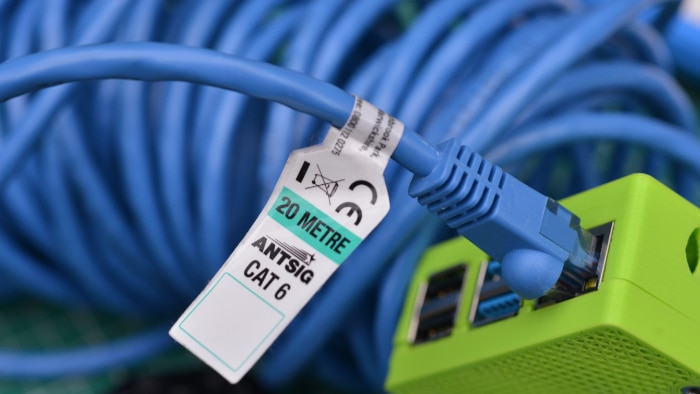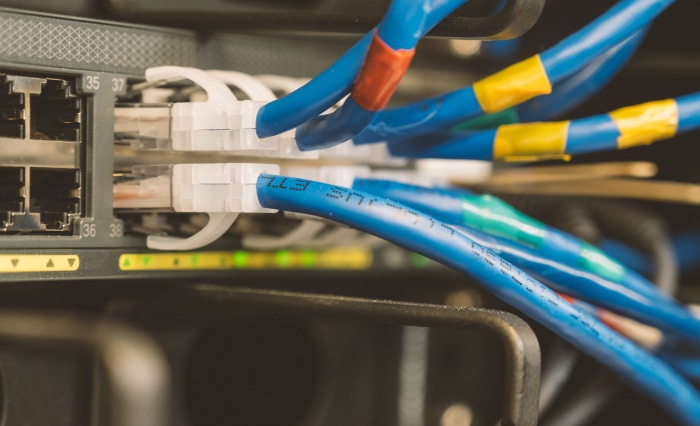Patch Cable vs. Ethernet Cable: Key Differences and Uses

Our reliance on the internet and connectivity has never been greater. Whether it’s for our personal use, like streaming films or music, or for business purposes such as video conferencing and data transfer, seamless and reliable connections are vital.
At the heart of these connections lie some unsung heroes that make all this possible – cables. In the world of networking, cables like Ethernet and Patch cables play pivotal roles in connecting our devices to the internet and to each other.
Ethernet cables and patch cables are common terms you’ll come across in the world of networking. However, it’s easy to get confused between the two, particularly because these terms are often used interchangeably in a variety of contexts.
This blog aims to shed light on what Ethernet cables and patch cables are, how they’re used, and what sets them apart from each other.
What is an Ethernet Cable?
An Ethernet cable is a type of networking cable used in wired networks. These cables connect various devices like computers, routers, and switches within a local area network (LAN).
These devices can then communicate and share resources efficiently. The term “Ethernet” refers to the protocol that defines how data should be formatted and processed for transmission.
Different Types of Ethernet Cables and Their Applications
Ethernet cables come in several types, each with its specifications and applications. The most commonly used Ethernet cables include:
Cat5 (Category 5) Ethernet Cable: This type of cable supports network speeds up to 100 Mbps and is most commonly used in older, slower networks. It has largely been replaced by newer standards, but can still be found in some legacy systems.
Cat5e (Category 5e) Ethernet Cable: An enhanced version of Cat5, Cat5e supports network speeds up to 1 Gbps. This type of cable reduces “crosstalk” (interference from adjacent wires) making it more efficient than its predecessor.
Cat6 (Category 6) Ethernet Cable: Cat6 cables can support speeds up to 10 Gbps over a limited distance, and 1 Gbps for longer distances. They offer better performance over Cat5e due to stricter standards for reducing crosstalk.
Cat6a (Category 6a) Ethernet Cable: An augmented version of Cat6, Cat6a supports 10 Gbps over a longer distance, with improved crosstalk reduction.
Cat7 (Category 7) Ethernet Cable: Cat7 cables offer even higher performance, supporting speeds up to 10 Gbps over 100 meters, with even stricter standards for crosstalk and noise reduction.
Advantages of Ethernet Cables
Ethernet cables provide several key benefits, including:
Speed: They offer high-speed data transfer rates, making them ideal for high-bandwidth applications like streaming and gaming.
Reliability: Ethernet connections are typically more reliable than wireless connections, with fewer disruptions and lower latency.
Security: Wired connections are more secure than wireless, as they’re harder to intercept.
Limitations of Ethernet Cables
Despite their advantages, Ethernet cables also have some limitations:
Physical constraints: The length of an Ethernet cable can affect signal quality. Typically, the maximum length for optimal performance is 100 meters.
Flexibility: Unlike wireless networks, setting up Ethernet connections can be more challenging, requiring physical cabling that may not be feasible in all environments.
What is a Patch Cable?
A patch cable, also known as a patch cord, is a type of Ethernet cable used to connect (“patch-in”) one electronic device to another for signal routing. These are typically short, flexible cables and are often used in settings like data centers and networking closets where devices are close together.
Different Types of Patch Cables and Their Applications
Like Ethernet cables, patch cables also come in different categories based on their specifications:
Cat5e Patch Cable: These are the enhanced version of the Cat5 patch cables, offering speeds of up to 1 Gbps. They are commonly used for patching in home and business networks.
Cat6 Patch Cable: With stricter standards for system noise and crosstalk, these cables offer performance up to 250 MHz and are ideal for high-speed networks.
Cat6a Patch Cable: This is an augmented version of the Cat6 cable and offers double the bandwidth. These cables support 10 Gbps speeds and are often used in professional and data center applications.
Cat7 Patch Cable: Offering a whopping 600 MHz performance, these are among the fastest patch cables and are ideal for data-intensive applications or environments where interference may be an issue.
Advantages of Patch Cables
Patch cables come with several benefits, such as:
Flexibility: Due to their short length and flexibility, patch cables are easy to install and manage, especially in cramped spaces.
Compatibility: Patch cables are versatile and can be used with a variety of devices, including computers, switches, and routers.
Cost-effective: Patch cables are relatively inexpensive, making them a practical choice for many networking situations.
Limitations of Patch Cables
Despite their usefulness, patch cables also have some limitations:
Length: Due to their design for short-range use, they are not suitable for long-distance connections.
Interference: Lower quality patch cables can be more susceptible to crosstalk and interference, affecting signal quality.
Patch Cable vs. Ethernet Cable

Before diving into the differences between patch cables and Ethernet cables, it’s important to clarify a common point of confusion.
In many contexts, these terms are used interchangeably, primarily because a patch cable is technically a type of Ethernet cable. However, not all Ethernet cables are patch cables. The distinguishing factor lies in the specific use-case scenario and physical characteristics of these cables.
Key Differences Between the Two
Here are some key differences between patch and Ethernet cables:
Length: Ethernet cables are typically longer and used for connections that need to cover larger distances. On the other hand, patch cables are generally shorter and are used for connecting devices in close proximity.
Flexibility: Patch cables are typically more flexible, making them easier to route and manage in small, crowded spaces like server rooms or between devices on a desk.
Purpose: Ethernet cables are used for various network connections, while patch cables are used for specific purposes like connecting a device to a network switch or router, or patching between panels in a data center.
Situational Usage: When to Use Which
Choosing between a patch cable and a standard Ethernet cable often comes down to the specific situation or application:
Patch Cables: If you are setting up a home network, connecting devices to a switch in a small business, or working in a server room or data center, patch cables are usually the best choice. Their flexibility and shorter length make them well-suited for these environments.
Ethernet Cables: For larger installations, like office buildings, wide area networks, or connections that need to cover larger distances (up to 100 meters for most categories), standard Ethernet cables would be the better choice.
Importance of Choosing the Right Cable for Your Needs
In summary, while patch cables and Ethernet cables share many similarities (since patch cables are a subset of Ethernet cables), the differences in their physical characteristics and typical use cases make it crucial to choose the right cable for your needs.
Understanding these differences will allow you to optimize your network setup, ensure efficient data transfer, and reduce potential issues related to cabling.
How to Choose the Right Cable for Your Networking Needs
Choosing the right cable for your networking needs is not always as simple as it might seem. It’s not just about picking the most advanced or expensive option; it’s about finding the right fit for your particular situation. Below are some key factors to consider and tips on making the right decision.
Factors to Consider When Choosing a Cable
Distance: Ethernet cables can support network connections over larger distances (up to 100 meters for most categories), while patch cables are designed for shorter, more direct connections. Consider the distance between the devices you need to connect when choosing a cable.
Data Rate: Different categories of cables support different data rates. If you need a cable for high-speed internet or high-bandwidth applications, you may need a higher category Ethernet or patch cable.
Environment: Consider the environment where the cable will be used. If you’re dealing with a crowded server room or need to route the cable through tight spaces, a flexible patch cable might be a better choice. For longer runs or outdoor use, a more durable Ethernet cable might be needed.
Compatibility: Make sure the cable you choose is compatible with the devices you want to connect. The cable should have the correct connectors (typically RJ-45) and be of the appropriate category to support the device’s network speed.
Tips on Choosing the Right Cable
Here are some practical tips to help guide your decision:
Understand Your Network Requirements: Are you setting up a home network, small business network, or a larger enterprise network? Higher category cables (Cat6, Cat6a, Cat7) may be more suitable for business networks that demand high-speed data transfers, while Cat5e might be sufficient for a home network.
Plan for the Future: If you plan to upgrade your network in the near future, it might be worth investing in higher category cables now to accommodate future speed and bandwidth needs.
Consider the Cost: Higher category cables are typically more expensive. While it’s important to get a cable that meets your needs, be mindful of your budget.
Quality Matters: Not all cables are created equal. Even cables in the same category can vary in quality. Look for cables from reputable manufacturers, and check user reviews to ensure you’re getting a good quality product.
Remember, the ultimate goal is to select a cable that offers the best balance of performance, cost-effectiveness, and future-proofing for your specific needs.
Conclusion
In the world of network connectivity, the importance of understanding the nuances of different cable types cannot be overstated. As we’ve explored in this blog post, while Ethernet and patch cables share many similarities, they each have unique characteristics and ideal use-cases that distinguish them from each other.
An Ethernet cable serves as the backbone of a wired network, providing reliable, high-speed data transmission over varying distances. They come in several categories, each offering different data rates and thus being suitable for different networking needs.
Patch cables, while a subset of Ethernet cables, are specifically designed for short, direct connections between devices. Their flexibility and shorter length make them an excellent choice for cramped spaces and specific applications like server rooms or home networks.
Understanding these differences is crucial to optimizing your network performance and efficiency. It’s not merely about picking the highest category or the most expensive option, but choosing the right cable based on the distance between devices, required data rate, working environment, and compatibility with your devices.
In essence, optimizing your network setup by choosing the right cable involves considering your current needs while also planning for future requirements. It’s about striking a balance between performance, cost-effectiveness, and future-proofing.



